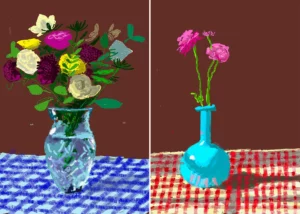
Kehinde Wiley is a remarkable storyteller, and I will tell you why that is. Let’s take a close look at his unique approach to portraiture:
- Reimagining Art History: Wiley’s work often reimagines traditional portraiture by featuring contemporary Black subjects in poses and settings reminiscent of historical European paintings. Through this juxtaposition, he challenges historical narratives and questions the absence of Black figures in classical art, thereby telling a story of inclusion, representation, and empowerment.
- Empowerment through Representation: Wiley’s portraits depict individuals from marginalized communities—particularly young Black men and women—in positions of power and dignity. By portraying his subjects with regal poses and vibrant, ornate backgrounds, he elevates their presence and asserts their importance in the cultural narrative. In doing so, he tells a story of resilience, strength, and beauty within communities often overlooked or misrepresented.
- Interplay of Identity and Culture: Wiley’s portraits are deeply rooted in exploring identity and cultural heritage. He often incorporates symbols, clothing, and accessories that reflect the subject’s personal identity and cultural background. Through these visual cues, he tells stories of cultural pride, heritage, and the complexities of identity in contemporary society.
- Global Perspective: Wiley’s artistic practice extends beyond the boundaries of the United States, with projects that involve collaborating with individuals from diverse cultural backgrounds around the world. Through these collaborations, he tells stories that transcend borders and celebrate the diversity of human experience on a global scale.
- Dialogue with the Viewer: Wiley’s portraits invite viewers to engage in a dialogue about representation, power dynamics, and the construction of identity. By presenting his subjects in larger-than-life scale and with commanding gazes, he compels viewers to confront their own preconceptions and biases, fostering empathy and understanding across cultural divides.
Kehinde Wiley’s art goes beyond mere representation—it challenges historical narratives, celebrates cultural diversity, and empowers marginalized communities. Through his innovative approach to portraiture, he creates visual narratives that resonate deeply with viewers, inviting them to reconsider their understanding of history, identity, and representation in contemporary society.
“Marketing is not anymore about the stuff you do but the stories you tell” is the quote of a famous marketeer, Seth Godin. What he wants to tell us with it, is that today we are accustomed to processing an enormous amount of information in a short amount of time through various channels. Whereas in the past, we would be confronted with three commercials during a movie break, today there are hundreds of brand messages that reach us more or less directly through Twitter, Instagram, Google, our email inbox, and so on.
Storytelling is the new way for good digital marketing. It is mainly images that are anchored in people’s minds. “Images are processed between 6 and 600 times faster than language.”
There are many stories out there, you may think. Surely, you regularly talk to customers in your gallery or at an art fair and have a sales conversation. Good gallery owners are good salespeople. They should know how to tell good stories that also work in marketing, right?
Not entirely: Storytelling means building an emotional connection with your target audience first, and then using it to “sell” in the second step.
Here are my suggestions for 4 Do’s and Don’ts you should consider when it comes to good art market storytelling:
The 4 Don’ts for Effective Storytelling
1 – Speaking to customers in jargon
While it’s important to showcase your expertise and knowledge as an artist or gallerist, using jargon and technical language can be confusing and alienating for potential buyers. Instead, try to communicate your ideas in clear and accessible language that everyone can understand.
2- Confusing storytelling with a sales pitch
While the ultimate goal of storytelling in the art market is to sell art, it’s important to avoid making your story sound like a sales pitch. Instead, focus on sharing your personal journey, inspirations and motivations, and let your potential buyers draw their own conclusions.
3 – Talking about something “cool” that happened recently
While it’s great to share exciting news and updates with your audience, it’s important to keep in mind that not everything that’s “cool” to you will be relevant or interesting to your potential buyers. Instead, try to focus on insights and perspectives that can help them better understand your art and connect with your story.
4 – Not knowing what your customers want and not addressing it
Finally, it’s essential to understand your potential buyers’ needs, preferences and interests, and tailor your storytelling accordingly. If you’re not sure what your audience is looking for, try to engage with them through social media, surveys or other channels, and use their feedback to inform your storytelling approach.
The 4 Dos for Effective Storytelling
1 – Speak in images
Rather than relying on dry descriptions or explanations, try to communicate your ideas through vivid and evocative imagery.
2- Leave room for imagination
Leave room for imagination: While it’s important to convey your message clearly, it’s also crucial to leave some space for your audience’s own interpretations and experiences. This can create a more dynamic and engaging dialogue between you and potential buyers.
3 – Be honest, talk about yourself
Authenticity is key when it comes to storytelling. Be true to yourself and your art, and avoid exaggerating or inventing details that don’t align with your personal narrative. This will help you to build trust and establish a genuine connection with your customers.
4 – Be constructive
Storytelling is not just about self-expression – it’s also an opportunity to inspire and educate your audience. Use your platform to share insights, perspectives and ideas that can help your audience to better appreciate your art and the wider cultural context in which it exists.
David Hockney, 20th March 2021, Flowers, Glass Vase on a Table (2021, left) and 28th February 2021, Roses in a Blue Vase (2021, right), both iPad paintings printed on paper, each from an edition of 50. © David Hockney
I remember visiting a wonderful exhibition in Nice called “Matisse – Hockney. Un paradis retrouvé”. Hockney’s colorful flower paintings, which he had painted in recent years, were displayed as masterpieces: bright bouquets hung in old ornate gold frames against dark painted walls. Only on closer inspection did one realize that they were digital images, painted on the iPad.
The 85-year-old Hockney spent the lockdown in a country house in Normandy and painted daily on the iPad. He sat there with a view of nature and waited for spring.
The story is as beautiful as the pictures. But why am I telling it? Because it reveals so much about good art marketing!
Good storytelling is more important than ever today! Why? Because it reaches people emotionally.
The American marketing magazine Adweek presented a study showing that customers are willing to pay 11% more for a work of art if they know the story behind it.
What stories can you tell? About you, your team, your art?
And what do art buyers look for? Art that just looks “pretty” above the dining table? Or art that they can tell a story about? Of course, the latter.
It is the personal stories that touch us the most. And make art accessible!
Storytelling removes barriers. Between the buyer, the gallery owner, and the work of art.
For example, we love stories of people who unexpectedly became famous. Like the story of Paul Schrader, the German shooting star painter who became an artist “overnight” from a lawyer.
Why can we all remember the name “Banksy”? Because the story of the anonymous artist who secretly leaves graffiti in public places is good. Quirky, adventurous.
So what does your company stand for? There must be plenty to tell!
Larry Gagosian is still known today as the world’s leading art dealer, with the image of a hands-on salesman, because he and the press repeatedly tell the story of how he sold posters on the streets in Los Angeles when he was a young man.
Hauser & Wirth gallery represents something completely different. They see art as a cultural asset and believe that it should be accessible to art enthusiasts beyond the boundaries of wealthy collectors. They invest large budgets in scientific articles, scholarships and organize exhibitions of museum quality.
Two very different gallery stories, but they remain “sticky” or memorable.
Everyone who is interested in art knows about the “blind art dealer”.
What about you?
What are your customers looking for from you that they can’t find anywhere else on the art market?
To find out, you should start with the answer to ONE question: the WHY.
If you know why you are selling what you are selling, you can create your own “mission statement” and tell a story that customers will remember.
Here are 5 questions that will help you create a brand identity, the WHY:
Why do I/we exist?
How did it come about?
Who are my/our main characters?
What problem do I/we solve?
What have I/we already failed at?
The last question is particularly nice, as it makes you relatable. And that’s what makes a good story.










